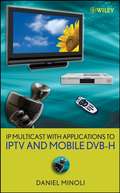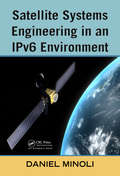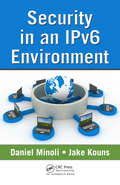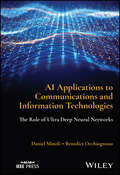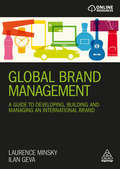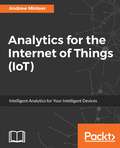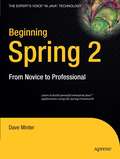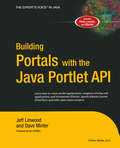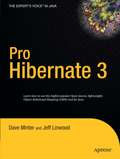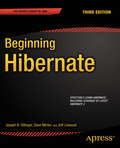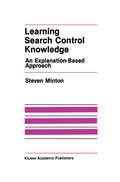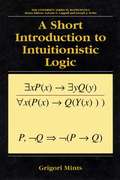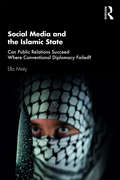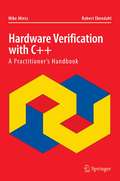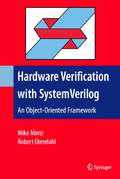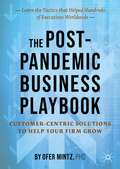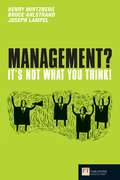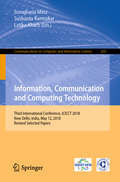- Table View
- List View
IP Multicast with Applications to IPTV and Mobile DVB-H (Wiley - IEEE)
by Daniel MinoliGet a clear picture of IP Multicast applications for delivering commercial high-quality video services This book provides a concise guide to current IP Multicast technology and its applications, with a focus on IP-based Television (IPTV) and Digital Video Broadcast-Handheld (DVB-H) applications—areas of tremendous commercial interest. Traditional phone companies can use IP Multicast technology to deliver video services over their networks; cell phone companies can use it to stream video to handheld phones and PDAs; and many cable TV companies are considering upgrading to IP technology. In addition to applications in industries seeking to provide high-quality digital video and audio, there are numerous other practical uses: multi-site corporate videoconferencing; broad distribution of financial data, stock quotes, and news bulletins; database replication; software distribution; and content caching (for example, Web site caching). After an introduction that gets readers up to speed on the basics, IP Multicast with Applications to IPTV and Mobile DVB-H: Discusses multicast addressing for payload and payload forwarding Covers routing in a variety of protocols, including PIM-SM, CBT, PIM-DM, DVMRP, and MOSPF Discusses multicasting in IPv6 environments and Multicast Listener Discovery (MLD) Features examples of IP Multicast applications in the IPTV and mobile DVB-H environments Includes reference RFCs and protocols placed in the proper context of a commercial-grade infrastructure for the delivery of robust, entertainment-quality linear and nonlinear video programming This is a concise, compact reference for practitioners who seek a quick, practical review of the topic with an emphasis on the major and most often used aspects of the technology. It serves as a hands-on resource for engineers in the communications industry or Internet design, content providers, and researchers. It's also an excellent text for college courses on IP Multicast and/or IPTV.
Satellite Systems Engineering in an IPv6 Environment
by Daniel MinoliCapitalize on Expert Foresight into the Future of Satellite Communication Satellite technology will maintain its key role in the evolving communications needs of government, military, IPTV, and mobile video industries because of its intrinsic multicast/broadcast capabilities, mobility aspects, global reach, reliability, and ability to quickly suppo
Security in an IPv6 Environment
by Daniel Minoli Jake KounsAnalyze Key Security Mechanisms and Approaches with this practical primer, the first book on the market to cover critical IPv6 security considerations.Dan Minoli, author of over 50 books on telecommunications and networks, and Jake Kouns, Chairman, CEO and CFO of the Open Security Foundation, discuss IPv6 security vulnerabilities, considerations, a
AI Applications to Communications and Information Technologies: The Role of Ultra Deep Neural Networks
by Daniel Minoli Benedict OcchiogrossoAI Applications to Communications and Information Technologies Apply the technology of the future to networking and communications. Artificial intelligence, which enables computers or computer-controlled systems to perform tasks which ordinarily require human-like intelligence and decision-making, has revolutionized computing and digital industries like few other developments in recent history. Tools like artificial neural networks, large language models, and deep learning have quickly become integral aspects of modern life. With research and development into AI technologies proceeding at lightning speeds, the potential applications of these new technologies are all but limitless. AI Applications to Communications and Information Technologies offers a cutting-edge introduction to AI applications in one particular set of disciplines. Beginning with an overview of foundational concepts in AI, it then moves through numerous possible extensions of this technology into networking and telecommunications. The result is an essential introduction for researchers and for technology undergrad/grad student alike. AI Applications to Communications and Information Technologies readers will also find: In-depth analysis of both current and evolving applications Detailed discussion of topics including generative AI, chatbots, automatic speech recognition, image classification and recognition, IoT, smart buildings, network management, network security, and more An authorial team with immense experience in both research and industry AI Applications to Communications and Information Technologies is ideal for researchers, industry observers, investors, and advanced students of network communications and related fields.
AI Applications to Communications and Information Technologies: The Role of Ultra Deep Neural Networks
by Daniel Minoli Benedict OcchiogrossoAI Applications to Communications and Information Technologies Apply the technology of the future to networking and communications. Artificial intelligence, which enables computers or computer-controlled systems to perform tasks which ordinarily require human-like intelligence and decision-making, has revolutionized computing and digital industries like few other developments in recent history. Tools like artificial neural networks, large language models, and deep learning have quickly become integral aspects of modern life. With research and development into AI technologies proceeding at lightning speeds, the potential applications of these new technologies are all but limitless. AI Applications to Communications and Information Technologies offers a cutting-edge introduction to AI applications in one particular set of disciplines. Beginning with an overview of foundational concepts in AI, it then moves through numerous possible extensions of this technology into networking and telecommunications. The result is an essential introduction for researchers and for technology undergrad/grad student alike. AI Applications to Communications and Information Technologies readers will also find: In-depth analysis of both current and evolving applications Detailed discussion of topics including generative AI, chatbots, automatic speech recognition, image classification and recognition, IoT, smart buildings, network management, network security, and more An authorial team with immense experience in both research and industry AI Applications to Communications and Information Technologies is ideal for researchers, industry observers, investors, and advanced students of network communications and related fields.
Global Brand Management: A Guide to Developing, Building & Managing an International Brand
by Laurence Minsky Ilan GevaIn today's hyper-connected world, any brand with a website or digital presence is 'global' by its very definition; yet in practice it takes an enormous amount of strategic planning and adaptability to successfully manage an international brand. Global Brand Management explores the increasingly universal scope of brand management. In an era when many brand managers will find themselves working for large multinationals operating across varied territories, categories and consumer groups, developing an understanding of both the opportunities and risks of multinational brands is truly essential. Meticulously researched, Global Brand Management shows readers how to manage an existing global brand, while simultaneously equipping them with the skills to build one from scratch. The text uses fascinating case studies including Oreo, Harley Davidson and Xiaomi to demonstrate the challenges of maintaining a stable brand identity when operating across territories with different languages, cultural values and logistics. With helpful pedagogy throughout and built-in features to enhance classroom learning, Global Brand Management is the perfect springboard for students to appreciate, enjoy and embrace the nuances and complexities of brand management on an international scale.
Global Brand Management: A Guide to Developing, Building & Managing an International Brand
by Laurence Minsky Ilan GevaIn today's hyper-connected world, any brand with a website or digital presence is 'global' by its very definition; yet in practice it takes an enormous amount of strategic planning and adaptability to successfully manage an international brand. Global Brand Management explores the increasingly universal scope of brand management. In an era when many brand managers will find themselves working for large multinationals operating across varied territories, categories and consumer groups, developing an understanding of both the opportunities and risks of multinational brands is truly essential. Meticulously researched, Global Brand Management shows readers how to manage an existing global brand, while simultaneously equipping them with the skills to build one from scratch. The text uses fascinating case studies including Oreo, Harley Davidson and Xiaomi to demonstrate the challenges of maintaining a stable brand identity when operating across territories with different languages, cultural values and logistics. With helpful pedagogy throughout and built-in features to enhance classroom learning, Global Brand Management is the perfect springboard for students to appreciate, enjoy and embrace the nuances and complexities of brand management on an international scale.
Analytics for the Internet of Things (IoT)
by Andrew MinteerBreak through the hype and learn how to extract actionable intelligence from the flood of IoT data About This Book • Make better business decisions and acquire greater control of your IoT infrastructure • Learn techniques to solve unique problems associated with IoT and examine and analyze data from your IoT devices • Uncover the business potential generated by data from IoT devices and bring down business costs Who This Book Is For This book targets developers, IoT professionals, and those in the field of data science who are trying to solve business problems through IoT devices and would like to analyze IoT data. IoT enthusiasts, managers, and entrepreneurs who would like to make the most of IoT will find this equally useful. A prior knowledge of IoT would be helpful but is not necessary. Some prior programming experience would be useful What You Will Learn • Overcome the challenges IoT data brings to analytics • Understand the variety of transmission protocols for IoT along with their strengths and weaknesses • Learn how data flows from the IoT device to the final data set • Develop techniques to wring value from IoT data • Apply geospatial analytics to IoT data • Use machine learning as a predictive method on IoT data • Implement best strategies to get the most from IoT analytics • Master the economics of IoT analytics in order to optimize business value In Detail We start with the perplexing task of extracting value from huge amounts of barely intelligible data. The data takes a convoluted route just to be on the servers for analysis, but insights can emerge through visualization and statistical modeling techniques. You will learn to extract value from IoT big data using multiple analytic techniques. Next we review how IoT devices generate data and how the information travels over networks. You'll get to know strategies to collect and store the data to optimize the potential for analytics, and strategies to handle data quality concerns. Cloud resources are a great match for IoT analytics, so Amazon Web Services, Microsoft Azure, and PTC ThingWorx are reviewed in detail next. Geospatial analytics is then introduced as a way to leverage location information. Combining IoT data with environmental data is also discussed as a way to enhance predictive capability. We'll also review the economics of IoT analytics and you'll discover ways to optimize business value. By the end of the book, you'll know how to handle scale for both data storage and analytics, how Apache Spark can be leveraged to handle scalability, and how R and Python can be used for analytic modeling. Style and approach This book follows a step-by-step, practical approach to combine the power of analytics and IoT and help you get results quickly
Beginning Spring 2: From Novice to Professional
by Dave MinterThis book will take developers through the first steps of using Spring whilst discussing the relevant technologies that Spring can be integrated with, what to be aware of and how working with Spring makes them easier to use. It focuses on the most useful features of Spring, including persistence and transaction management as well as the complete Spring web tools portfolio, and also introduces 3-tier application design and how to test these designs. Ideal for J2EE beginners, this book provides a broad insight into Spring’s enterprise Java-based technologies, whilst showing how to use Spring correctly.
Building Portals with the Java Portlet API
by Dave Minter Jeff Linwood* Covers the brand new Portlet Specification (JSR-168) to provide a standard API to portal applications. * Focuses on the key issues of portal development including integration, security and single sign-on. * Readers can learn how to port existing applications into the new portal environment firsthand from Jeff Linwood who helped to create the actual specification. * Readers can learn how to port existing applications into the new portal environment firsthand from Jeff Linwood who helped to create the actual specifications.
Pro Hibernate 3
by Dave Minter Jeff Linwood* First to market with complete Hibernate 3 coverage and real-world application design tips. * Comprehensive reference for Hibernate object relational mapping strategies. * Integrated approach to database and Java application design.
Beginning Hibernate: An Introduction To All The New Featres Of The Hibernate 3.2 Persistense Api
by Dave Minter Jeff Linwood Joseph OttingerBeginning Hibernate, Third Edition is ideal if you’re experienced in Java with databases (the traditional, or "connected," approach), but new to open-source, lightweight Hibernate, a leading object-relational mapping and database-oriented application development framework.This book packs in information about the release of the Hibernate 4.x persistence layer and provides a clear introduction to the current standard for object-relational persistence in Java. And since the book keeps its focus on Hibernate without wasting time on nonessential third-party tools, you’ll be able to immediately start building transaction-based engines and applications.Experienced authors Joseph Ottinger with Dave Minter and Jeff Linwood provide more in-depth examples than any other book for Hibernate beginners. The authors also present material in a lively, example-based manner—not a dry, theoretical, hard-to-read fashion.
Learning Search Control Knowledge: An Explanation-Based Approach (The Springer International Series in Engineering and Computer Science #61)
by Steven MintonThe ability to learn from experience is a fundamental requirement for intelligence. One of the most basic characteristics of human intelligence is that people can learn from problem solving, so that they become more adept at solving problems in a given domain as they gain experience. This book investigates how computers may be programmed so that they too can learn from experience. Specifically, the aim is to take a very general, but inefficient, problem solving system and train it on a set of problems from a given domain, so that it can transform itself into a specialized, efficient problem solver for that domain. on a knowledge-intensive Recently there has been considerable progress made learning approach, explanation-based learning (EBL), that brings us closer to this possibility. As demonstrated in this book, EBL can be used to analyze a problem solving episode in order to acquire control knowledge. Control knowledge guides the problem solver's search by indicating the best alternatives to pursue at each choice point. An EBL system can produce domain specific control knowledge by explaining why the choices made during a problem solving episode were, or were not, appropriate.
A Short Introduction to Intuitionistic Logic (University Series in Mathematics)
by Grigori MintsIntuitionistic logic is presented here as part of familiar classical logic which allows mechanical extraction of programs from proofs. to make the material more accessible, basic techniques are presented first for propositional logic; Part II contains extensions to predicate logic. This material provides an introduction and a safe background for reading research literature in logic and computer science as well as advanced monographs. Readers are assumed to be familiar with basic notions of first order logic. One device for making this book short was inventing new proofs of several theorems. The presentation is based on natural deduction. The topics include programming interpretation of intuitionistic logic by simply typed lambda-calculus (Curry-Howard isomorphism), negative translation of classical into intuitionistic logic, normalization of natural deductions, applications to category theory, Kripke models, algebraic and topological semantics, proof-search methods, interpolation theorem. The text developed from materal for several courses taught at Stanford University in 1992-1999.
Social Media and the Islamic State: Can Public Relations Succeed Where Conventional Diplomacy Failed?
by Ella MintyThis book examines how social media has transformed extremist discourse. Drawing on ISIS and their sophisticated use of social media platforms and PR concepts, it explores the ways in which the outfit was able to recruit, mobilise and spread fundamentalist propaganda in regions where it had little physical presence. One of the first studies to draw a link between international diplomacy, the rise of fundamentalism and public relations, this book will be of great interest to scholars and researchers of defence and strategic studies, especially those working on ISIS propaganda, Middle East Studies, media studies, digital humanities, communication studies, public relations and international relations, as well general readers.
Social Media and the Islamic State: Can Public Relations Succeed Where Conventional Diplomacy Failed?
by Ella MintyThis book examines how social media has transformed extremist discourse. Drawing on ISIS and their sophisticated use of social media platforms and PR concepts, it explores the ways in which the outfit was able to recruit, mobilise and spread fundamentalist propaganda in regions where it had little physical presence. One of the first studies to draw a link between international diplomacy, the rise of fundamentalism and public relations, this book will be of great interest to scholars and researchers of defence and strategic studies, especially those working on ISIS propaganda, Middle East Studies, media studies, digital humanities, communication studies, public relations and international relations, as well general readers.
Hardware Verification with C++: A Practitioner’s Handbook
by Mike Mintz Robert EkendahlDescribes a small verification library with a concentration on user adaptability such as re-useable components, portable Intellectual Property, and co-verification.Takes a realistic view of reusability and distills lessons learned down to a tool box of techniques and guidelines.
Hardware Verification with System Verilog: An Object-Oriented Framework
by Mike Mintz Robert EkendahlVerification is increasingly complex, and SystemVerilog is one of the languages that the verification community is turning to. However, no language by itself can guarantee success without proper techniques. Object-oriented programming (OOP), with its focus on managing complexity, is ideally suited to this task. With this handbook—the first to focus on applying OOP to SystemVerilog—we’ll show how to manage complexity by using layers of abstraction and base classes. By adapting these techniques, you will write more "reasonable" code, and build efficient and reusable verification components. Both a learning tool and a reference, this handbook contains hundreds of real-world code snippets and three professional verification-system examples. You can copy and paste from these examples, which are all based on an open-source, vendor-neutral framework (with code freely available at www.trusster.com). Learn about OOP techniques such as these: Creating classes—code interfaces, factory functions, reuse Connecting classes—pointers, inheritance, channels Using "correct by construction"—strong typing, base classes Packaging it up—singletons, static methods, packages
The Post-Pandemic Business Playbook: Customer-Centric Solutions to Help Your Firm Grow
by Ofer MintzCOVID-19 forced a dramatic change to customer behavior that resulted in an economic crisis not witnessed by anyone alive. Businesses can no longer operate as before because their customers are no longer operating as before. This book provides customer-centric based guidance for how businesses should adapt to this new reality, deriving insights from academic research, case studies, interviews, and best practice examples from around the world. As validated by hundreds of top-level executives, its readers will gain a better understanding of why customer behavior has changed so they can use the book’s solutions to navigate through and succeed in the post COVID-19 future.
Management e-book: It's not what you think (Financial Times Series)
by Henry Mintzberg Bruce Ahlstrand Joseph LampelNo Synopsis.
Information, Communication and Computing Technology: Third International Conference, ICICCT 2018, New Delhi, India, May 12, 2018, Revised Selected Papers (Communications in Computer and Information Science #835)
by Sonajharia Minz Sushanta Karmakar Latika KharbThis book constitutes the refereed proceedings of the Third International Conference on Information, Communication and Computing Technology, ICICCT 2018, held in New Delhi, India, in May 2018.The 18 revised full papers presented in this volume were carefully reviewed and selected from 295 submissions. The papers are organized in topical sections on communication and network systems and emerging computing technologies.
Advances in the Design of Symbolic Computation Systems (Texts & Monographs in Symbolic Computation)
by Alfonso Miola Marco TemperiniNew methodological aspects related to design and implementation of symbolic computation systems are considered in this volume aiming at integrating such aspects into a homogeneous software environment for scientific computation. The proposed methodology is based on a combination of different techniques: algebraic specification through modular approach and completion algorithms, approximated and exact algebraic computing methods, object-oriented programming paradigm, automated theorem proving through methods à la Hilbert and methods of natural deduction. In particular the proposed treatment of mathematical objects, via techniques for method abstraction, structures classification, and exact representation, the programming methodology which supports the design and implementation issues, and reasoning capabilities supported by the whole framework are described.
Social Collective Intelligence: Combining the Powers of Humans and Machines to Build a Smarter Society (Computational Social Sciences)
by Daniele Miorandi Vincenzo Maltese Michael Rovatsos Anton Nijholt James StewartThe book focuses on Social Collective Intelligence, a term used to denote a class of socio-technical systems that combine, in a coordinated way, the strengths of humans, machines and collectives in terms of competences, knowledge and problem solving capabilities with the communication, computing and storage capabilities of advanced ICT.Social Collective Intelligence opens a number of challenges for researchers in both computer science and social sciences; at the same time it provides an innovative approach to solve challenges in diverse application domains, ranging from health to education and organization of work.The book will provide a cohesive and holistic treatment of Social Collective Intelligence, including challenges emerging in various disciplines (computer science, sociology, ethics) and opportunities for innovating in various application areas.By going through the book the reader will gauge insight and knowledge into the challenges and opportunities provided by this new, exciting, field of investigation. Benefits for scientists will be in terms of accessing a comprehensive treatment of the open research challenges in a multidisciplinary perspective. Benefits for practitioners and applied researchers will be in terms of access to novel approaches to tackle relevant problems in their field. Benefits for policy-makers and public bodies representatives will be in terms of understanding how technological advances can support them in supporting the progress of society and economy.
Advancement of Deep Learning and its Applications in Object Detection and Recognition
by Roohie Naaz Mir Vipul Kumar Sharma Ranjeet Kumar Rout Saiyed UmerObject detection is a basic visual identification problem in computer vision that has been explored extensively over the years. Visual object detection seeks to discover objects of specific target classes in a given image with pinpoint accuracy and apply a class label to each object instance. Object recognition strategies based on deep learning have been intensively investigated in recent years as a result of the remarkable success of deep learning-based image categorization. In this book, we go through in detail detector architectures, feature learning, proposal generation, sampling strategies, and other issues that affect detection performance. The book describes every newly proposed novel solution but skips through the fundamentals so that readers can see the field's cutting edge more rapidly. Moreover, unlike prior object detection publications, this project analyses deep learning-based object identification methods systematically and exhaustively, and also gives the most recent detection solutions and a collection of noteworthy research trends. The book focuses primarily on step-by-step discussion, an extensive literature review, detailed analysis and discussion, and rigorous experimentation results. Furthermore, a practical approach is displayed and encouraged.
Advancement of Deep Learning and its Applications in Object Detection and Recognition
by Roohie Naaz Mir Vipul Kumar Sharma Ranjeet Kumar Rout Saiyed UmerObject detection is a basic visual identification problem in computer vision that has been explored extensively over the years. Visual object detection seeks to discover objects of specific target classes in a given image with pinpoint accuracy and apply a class label to each object instance. Object recognition strategies based on deep learning have been intensively investigated in recent years as a result of the remarkable success of deep learning-based image categorization. In this book, we go through in detail detector architectures, feature learning, proposal generation, sampling strategies, and other issues that affect detection performance. The book describes every newly proposed novel solution but skips through the fundamentals so that readers can see the field's cutting edge more rapidly. Moreover, unlike prior object detection publications, this project analyses deep learning-based object identification methods systematically and exhaustively, and also gives the most recent detection solutions and a collection of noteworthy research trends. The book focuses primarily on step-by-step discussion, an extensive literature review, detailed analysis and discussion, and rigorous experimentation results. Furthermore, a practical approach is displayed and encouraged.
